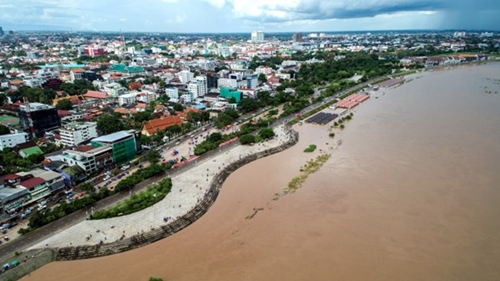The collaboration, the first of its kind, aims to raise awareness among the general public in the four MRC member countries – Cambodia, Laos, Thailand and Vietnam – about the MRC’s flood and drought information systems and to build capacity for relevant officials on the use of online digital systems during 2020-2021.
According to a United Nations report on Economic Losses, Poverty and Disasters, the last two decades have seen direct economic losses from climate-related disasters increase by up to 250 percent. In the Mekong region during 1998-2017, Thailand was worst hit, suffering losses estimated at 52.4 billion USD.
    |
 |
|
The Mekong River Commission (MRC) Secretariat and Facebook on August 31 launch a collaboration initiative to provide early flood alert and drought monitoring information to riparian communities and governments in the Lower Mekong region. |
The MRC estimates that while seasonal flooding brings diverse benefits to the region, the average annual cost of flood in the Lower Mekong Basin is approximately 60-70 million USD. Cambodia and Vietnam alone account for approximately two-thirds of the Mekong region’s total annual flood damage.
Recent MRC studies also show that drought in the Lower Mekong Basin has increased in frequency and severity in the past decades and this trend is set to continue. The basin is also vulnerable to additional climate change impacts that include a predicted mean temperature rise of approximately 0.8 degrees Celsius by 2030.
“We see the utmost importance of providing timely and reliable information on water levels to Mekong countries and communities exposed to flood and drought and an ever changing climate so that they can take action in time to avoid or reduce their risk and prepare an effective response,” said Dr Anoulak Kittikhoun, MRCS Chief Strategy and Partnership Officer.
The MRC has installed 22 hydrological stations along the main channel of the Mekong River in the Lower Mekong Basin to monitor and collect river water level and rainfall data, which feeds into its Mekong Flood and Drought Forecasting System. The system provides the public and riparian governments with data on daily river water levels, including flood alerts and drought forecasting, throughout the year. The system will be explained through a 3D animated video, which will be shared on Facebook’s platform to reach communities across the region.
Facebook will also train relevant officials from the four MRC member countries on how to use different digital tools to communicate effectively and quickly during and after a disaster. This will include training on Facebook’s Population Density Maps, an application that uses state-of-the-art computer visual techniques to combine publicly and commercially available datasets with Facebook’s AI capabilities. The maps are three times more detailed than available sources.
Source: VNA